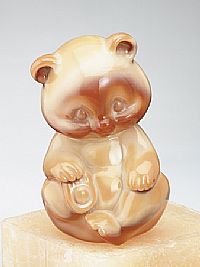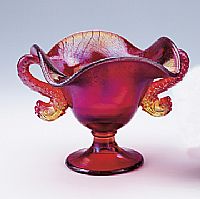|
Welcome to Almost Heaven Antiques page that is both about Fenton Art Glass, and represents our showcase of Fenton products!
What is Art Glass?
Art glass normally means the modern art glass movement in which individual artists working alone or with a few assistants
to create works from molten glass in relatively small furnaces of a few hundred pounds of glass. It began in the early 1960s
and showed continued growth through the end of the century. The glass objects created are not primarily utilitarian but are
intended to make a sculptural or decorative statement. On the market, their prices may range from a few hundred to tens of
thousands of dollars (US). The best known of the moderns is Dale Chihuly who uses many of the best independent glass workers
to create his large and colorful works.
Prior to the early 1960s, art glass would have referred to glass made for decorative use, usually by teams of factory
workers, taking glass from furnaces with a thousand or more pounds of glass. This form of art glass, of which Tiffany and
Steuben in the U.S.A., Gallé in France and Hoya Crystal in Japan and Kosta Boda in Sweden are perhaps the best known, grew
out of the factory system in which all glass objects were hand or mold blown by teams of 4 or more men. In fact, the turn
of the 19th Century was the height of the old art glass movement while the factory glass blowers were being replaced by mechanical
bottle blowing and continuous window glass. In the factory, every member of the team does the same job repeatedly turning
out dozens or hundreds of the same item in a days work.
In an art glass studio, ideally, "production work" (goblets, vases, pitchers, art marbles etc.) shows more hand
worked variation than was allowed in pure factory work environment and each piece shows some of the lead glass worker's creativity,
the gaffer. In addition to smaller production pieces, most studio glass workers also try to turn out larger individual pieces
which might be the equivalent of a master piece in the journeyman system of guild and factory work
Fenton History:
Fenton Art Glass Company is the largest manufacturer of handmade colored glass in the United States.
The Fenton Art Glass Company was founded in 1905 by Frank L. Fenton and his brother John W. Fenton in an old glass factory
building in Martins Ferry, Ohio. They began by painting decorations on glass blanks made by other glass manufacturers. Soon,
being unable to get the glass they needed, they decided to produce their own glass. The first glass from the new Fenton factory
in Williamstown, West Virginia, was made on January 2, 1907. During the years from 1905 to the 1920's, Fenton design was heavily
influenced by the artists at Tiffany and Steuben. In late 1907, Fenton introduced "Iridescent" glass. This glass,
now known as "Carnival" glass, is a popular collectible today. During the 1930's and 1940's, Fenton produced practical
items, such as mixing bowls and tableware to get through the depression and WWII shortages. They continued working on developing
a wide array of new colors. In the late 1940's, the top three members of the Fenton management team died, leaving Frank M.
Fenton, age 33, and Wilmer C. (Bill) Fenton, age 25, to step in and take over as President and Vice President. In spite of
other glass factories closing at a rapid rate, Frank and Bill led the Fenton factory through significant American growth for
the next 30 years. In 1986, the leadership of the company passed on to the third generation, with George W. Fenton, Frank
M's son, taking over as President. Today nine Fenton family members work together along with over 400 employees to create
handmade glass artistry that isloved by collectors around the world. Fenton is known for its beautiful colors and patterns.
Each piece of glass is an artistic creation by skilled glassworkers and decorators.
The Fenton Promise:
To gift buyers, home decorators and collectors who value unique, handcrafted and handpainted art glass that has been appreciated
for generations. Fenton promises an extensive variety of appealing products crafted in distinctive colors and styles by skilled
American artisans. Each piece of glass imparts a sense of heritage, pride of ownership, and excitement in sharing the Fenton
experience. Fenton will continue to be a creative and responsive company committed to perfecting its craft and being recognized
throughout world markets as the leading source of high-quality handcrafted colored glass. Fenton, a family tradition since
1905.
The Fenton Time line:
1905
With $284.86, Frank L. Fenton and his brother John start the Fenton Art Glass Company, renting space in the Haskins Glass
Co. building in Martins Ferry, Ohio. They buy glass blanks on which they paint decoration. Soon, they have trouble acquiring
glass, so they decide to produce their own.
1906-7
The Fentons build a factory in Williamstown, West Virginia. The first piece made is a crystal cream pitcher with a Water
Lily and Cattails pattern.
1910
After several successful years, Frank L. Fenton is named President, Treasurer and General Manager.
1925
Frank's brother Robert C. Fenton is appointed Vice President, Secretary and Sales Manager.
1939
Baskets, Cranberry glass, crested ware, and the Hobnail pattern all debut in the late 1930s.
1948
With the passing of Frank and Robert C. Fenton, Frank M. Fenton becomes President. Wilmer C. "Bill" Fenton becomes
Vice-President. Together, they lead the factory through significant growth for nearly four decades.
1952
Milk glass Hobnail becomes Fenton's flagship pattern. Years later, Bill Fenton fondly calls Hobnail our "bread and
butter" line.
1969
Fenton and Cracker Barrel begin a business relationship. Fenton created a special item for Cracker Barrel's 30th Anniversary
in 1999.
1978
Frank M. Fenton accepts the position of Chairman of the Board, and Bill Fenton becomes President.
1980-1989
The first Connoisseur Collection is offered in 1983. Throughout the 1980s, Fenton's Milk Glass, Burmese and Rosalene colors
continue to rise in popularity.
1986
George W. Fenton becomes President, and he remains at the helm today. Bill Fenton is named Chairman of the Board, and
Frank M. Fenton retires to the position of Historian.
1988
Fenton appears on QVC with Bill Fenton as the first on-air guest. Today on-air guests include George Fenton, Scott Fenton,
Nancy Fenton and Shelley Fenton-Ash. Fenton published a book titled Fenton Glass: Especially for QVC in 2002.
1994
Fenton's Showcase Dealer Program begins with 235 dealers. Today there are more than 1,000 Showcase Dealers nationwide.
1996
The premier issue of the Glass Messenger, a quarterly newsletter for Fenton collectors, is published. A Roselle on Cranberry
Basket is offered as the first Subscriber Exclusive.
2000
Fenton celebrates the company's 95th Anniversary! Fenton launches web site: www.fentonartglass.com
2004
Fenton publishes a coffee table book titled FENTON: Handcrafted American Glass Artistry
2005
May 4, 2005 - Fenton turns 100! Fenton Centennial Celebration in Williamstown July 31-August 2.
For a history of the Fenton Logo, click here: http://www.fentonartglass.com/history/logos.htm
For a history of the Fenton labels, click here: http://www.fentonartglass.com/history/logos.htm
These are some of the fine offerings we will have right here in the shop straight from the Fenton factory!








|
